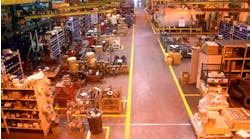Don’t fall behind when it comes to applying machine learning in your facility. Employing analytics with the mass of data collected in your facility can help you cut costs across the board.
There are five steps key to getting the most out of machine learning, according to Ash Awad, Chief Market Officer at McKinstry, a design, build, operate and maintain firm. Follow this blueprint to optimize your building through data analytics.
Related: Machine Learning 101: Is Predictive Analytics Possible in Your Facility?
1) Unlock Data in the Built Environment
The more data you have access to, the greater the insights you will yield. Using a networked control system with your building’s systems, you can begin harvesting data.
“If I were a facility manager, unlocking data effectively and efficiently would be the No. 1 thing I’d be seeking out,” explains Awad. “I would work to unlock more data than I thought I needed.”
If you can successfully unlock data from all of your building systems, you give yourself many more opportunities to identify inefficiencies across the board.
2) Analyze Data
Once you have access to a wealth of data, start putting it into context. Analyzing the data will help you develop key actions. Your control system will provide many insights, but you can look at the data in some instances on your own.
“If you get the data out, you can then start to do analysis on the data, some of which you can use outside firms to analyze and some you might be able to do yourself,” explains Awad.
For example, your control system might not tell you whether equipment is cycling on and off against a schedule, notes Awad. Looking at this data over time might eventually reveal that some pieces of equipment are cycling on and off or are staying on when they should be off. Ultimately, it’s a practice of recognizing patterns you typically wouldn’t.
3) Sharing Analysis and Data
More detail about the bottom line is always welcome when meeting with your organization’s upper management. Getting the most out of machine learning involves sharing this information.
“As a facility manager, you might have information that your financial folks might be interested in,” says Awad. “You might have data and analysis for utility and energy costs that you can put into reasonable equipment replacement schedules that are not just, ‘I think this equipment is old and failing.’ You can point your findings to other parties so they can run their own analysis.”
Read also: From Data to Dollars
The data and analysis revealed through machine learning aren’t just valuable to your own operational goals. This data is also valuable to other stakeholders in your organization.
4) Create Action
If you properly enact the previous three steps, you’ll be able to capitalize, and the savings will begin. Once your data is telling the right story, it’s time to take action and improve your facility’s efficiency.
On topic: How to Get the Most out of Your Air Filtration System
“Where analytics has failed in the past is that there has been too little data or the data has not been fully understood or utilized well enough,” says Awad. “So when it comes time to act, no one can really act robustly on that information stream. If you get the right data and analytics, and you share it with the right people, you can actually act on it. “
Machine learning helps the built environment run collectively, which is the Holy Grail for facilities, explains Awad. The right application of machine learning can improve total operational efficiency – not just energy – by 50%, he adds
5) Change Behaviors
As you continue to take action with the insights you have received from machine learning, you can create positive cultural shifts in your organization. With machine learning, you will also learn a lot about your building. The cumulative actions you take will eventually become improved behaviors.
“A lot of resources and energy are being wasted, so if we have enough of this information and action, we can start to see patterns that change standard operating procedures,” says Awad. “In totality, we’re trying to change behaviors by making both buildings and occupants smarter.”
Justin Feit was previously the Associate Editor of BUILDINGS.


